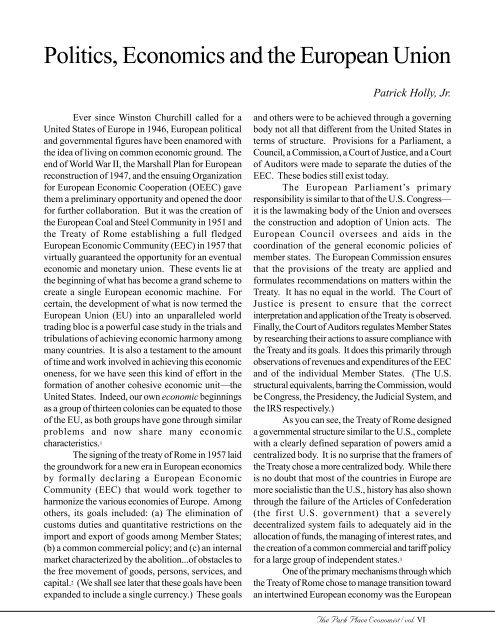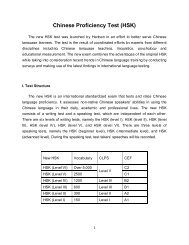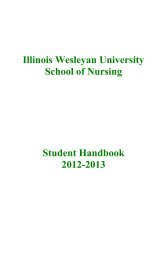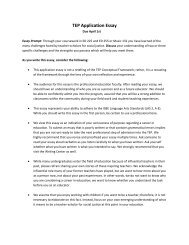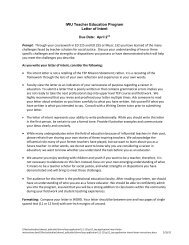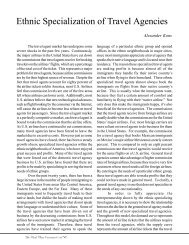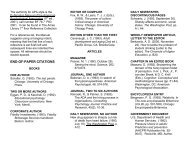Politics, Economics and the European Union
Politics, Economics and the European Union
Politics, Economics and the European Union
Create successful ePaper yourself
Turn your PDF publications into a flip-book with our unique Google optimized e-Paper software.
<strong>Politics</strong>, <strong>Economics</strong> <strong>and</strong> <strong>the</strong> <strong>European</strong> <strong>Union</strong><br />
Patrick Holly, Jr.<br />
Ever since Winston Churchill called for a<br />
United States of Europe in 1946, <strong>European</strong> political<br />
<strong>and</strong> governmental figures have been enamored with<br />
<strong>the</strong> idea of living on common economic ground. The<br />
end of World War II, <strong>the</strong> Marshall Plan for <strong>European</strong><br />
reconstruction of 1947, <strong>and</strong> <strong>the</strong> ensuing Organization<br />
for <strong>European</strong> Economic Cooperation (OEEC) gave<br />
<strong>the</strong>m a preliminary opportunity <strong>and</strong> opened <strong>the</strong> door<br />
for fur<strong>the</strong>r collaboration. But it was <strong>the</strong> creation of<br />
<strong>the</strong> <strong>European</strong> Coal <strong>and</strong> Steel Community in 1951 <strong>and</strong><br />
<strong>the</strong> Treaty of Rome establishing a full fledged<br />
<strong>European</strong> Economic Community (EEC) in 1957 that<br />
virtually guaranteed <strong>the</strong> opportunity for an eventual<br />
economic <strong>and</strong> monetary union. These events lie at<br />
<strong>the</strong> beginning of what has become a gr<strong>and</strong> scheme to<br />
create a single <strong>European</strong> economic machine. For<br />
certain, <strong>the</strong> development of what is now termed <strong>the</strong><br />
<strong>European</strong> <strong>Union</strong> (EU) into an unparalleled world<br />
trading bloc is a powerful case study in <strong>the</strong> trials <strong>and</strong><br />
tribulations of achieving economic harmony among<br />
many countries. It is also a testament to <strong>the</strong> amount<br />
of time <strong>and</strong> work involved in achieving this economic<br />
oneness, for we have seen this kind of effort in <strong>the</strong><br />
formation of ano<strong>the</strong>r cohesive economic unit—<strong>the</strong><br />
United States. Indeed, our own economic beginnings<br />
as a group of thirteen colonies can be equated to those<br />
of <strong>the</strong> EU, as both groups have gone through similar<br />
problems <strong>and</strong> now share many economic<br />
characteristics. 1<br />
The signing of <strong>the</strong> treaty of Rome in 1957 laid<br />
<strong>the</strong> groundwork for a new era in <strong>European</strong> economics<br />
by formally declaring a <strong>European</strong> Economic<br />
Community (EEC) that would work toge<strong>the</strong>r to<br />
harmonize <strong>the</strong> various economies of Europe. Among<br />
o<strong>the</strong>rs, its goals included: (a) The elimination of<br />
customs duties <strong>and</strong> quantitative restrictions on <strong>the</strong><br />
import <strong>and</strong> export of goods among Member States;<br />
(b) a common commercial policy; <strong>and</strong> (c) an internal<br />
market characterized by <strong>the</strong> abolition...of obstacles to<br />
<strong>the</strong> free movement of goods, persons, services, <strong>and</strong><br />
capital. 2 (We shall see later that <strong>the</strong>se goals have been<br />
exp<strong>and</strong>ed to include a single currency.) These goals<br />
<strong>and</strong> o<strong>the</strong>rs were to be achieved through a governing<br />
body not all that different from <strong>the</strong> United States in<br />
terms of structure. Provisions for a Parliament, a<br />
Council, a Commission, a Court of Justice, <strong>and</strong> a Court<br />
of Auditors were made to separate <strong>the</strong> duties of <strong>the</strong><br />
EEC. These bodies still exist today.<br />
The <strong>European</strong> Parliament’s primary<br />
responsibility is similar to that of <strong>the</strong> U.S. Congress—<br />
it is <strong>the</strong> lawmaking body of <strong>the</strong> <strong>Union</strong> <strong>and</strong> oversees<br />
<strong>the</strong> construction <strong>and</strong> adoption of <strong>Union</strong> acts. The<br />
<strong>European</strong> Council oversees <strong>and</strong> aids in <strong>the</strong><br />
coordination of <strong>the</strong> general economic policies of<br />
member states. The <strong>European</strong> Commission ensures<br />
that <strong>the</strong> provisions of <strong>the</strong> treaty are applied <strong>and</strong><br />
formulates recommendations on matters within <strong>the</strong><br />
Treaty. It has no equal in <strong>the</strong> world. The Court of<br />
Justice is present to ensure that <strong>the</strong> correct<br />
interpretation <strong>and</strong> application of <strong>the</strong> Treaty is observed.<br />
Finally, <strong>the</strong> Court of Auditors regulates Member States<br />
by researching <strong>the</strong>ir actions to assure compliance with<br />
<strong>the</strong> Treaty <strong>and</strong> its goals. It does this primarily through<br />
observations of revenues <strong>and</strong> expenditures of <strong>the</strong> EEC<br />
<strong>and</strong> of <strong>the</strong> individual Member States. (The U.S.<br />
structural equivalents, barring <strong>the</strong> Commission, would<br />
be Congress, <strong>the</strong> Presidency, <strong>the</strong> Judicial System, <strong>and</strong><br />
<strong>the</strong> IRS respectively.)<br />
As you can see, <strong>the</strong> Treaty of Rome designed<br />
a governmental structure similar to <strong>the</strong> U.S., complete<br />
with a clearly defined separation of powers amid a<br />
centralized body. It is no surprise that <strong>the</strong> framers of<br />
<strong>the</strong> Treaty chose a more centralized body. While <strong>the</strong>re<br />
is no doubt that most of <strong>the</strong> countries in Europe are<br />
more socialistic than <strong>the</strong> U.S., history has also shown<br />
through <strong>the</strong> failure of <strong>the</strong> Articles of Confederation<br />
(<strong>the</strong> first U.S. government) that a severely<br />
decentralized system fails to adequately aid in <strong>the</strong><br />
allocation of funds, <strong>the</strong> managing of interest rates, <strong>and</strong><br />
<strong>the</strong> creation of a common commercial <strong>and</strong> tariff policy<br />
for a large group of independent states. 3<br />
One of <strong>the</strong> primary mechanisms through which<br />
<strong>the</strong> Treaty of Rome chose to manage transition toward<br />
an intertwined <strong>European</strong> economy was <strong>the</strong> <strong>European</strong><br />
The Park Place Economist / vol. VI
<strong>Politics</strong>, <strong>Economics</strong> <strong>and</strong> <strong>the</strong> <strong>European</strong> <strong>Union</strong><br />
Investment Bank (EIB). “The task of <strong>the</strong> <strong>European</strong><br />
Investment Bank, <strong>the</strong> <strong>European</strong> <strong>Union</strong>’s financing<br />
institution, is to contribute towards <strong>the</strong> integration,<br />
balanced development <strong>and</strong> economic <strong>and</strong> social<br />
cohesion of <strong>the</strong> Member Countries. To this end, it<br />
raises on <strong>the</strong> markets substantial volumes of funds<br />
which it directs...towards financing capital projects<br />
according with <strong>the</strong> objectives of <strong>the</strong> <strong>Union</strong>.” 4 In o<strong>the</strong>r<br />
words, <strong>the</strong> EIB was created to balance <strong>the</strong> economies<br />
of <strong>the</strong> Member States by encouraging investment in<br />
<strong>the</strong> poorer countries.<br />
As time wore on after <strong>the</strong> Treaty of Rome was<br />
signed, <strong>the</strong>re grew a desire <strong>and</strong> a<br />
need for a common monetary<br />
policy complete with monetary<br />
integration. “As early as 1962,<br />
<strong>the</strong> Marjolin memor<strong>and</strong>um<br />
pointed out that, whereas <strong>the</strong><br />
Treaty of Rome had foreseen a<br />
common trade policy, it had not<br />
envisaged a common monetary<br />
policy; it was felt that this lacuna<br />
should be filled.” 5 Since <strong>the</strong><br />
Treaty of Rome subjected<br />
exchange rates for Member States<br />
to narrow fluctuation margins,<br />
this memor<strong>and</strong>um revealed that<br />
after a period of transition, it would be necessary to<br />
fix exchange rates <strong>and</strong> head towards a single currency<br />
before <strong>the</strong> management of <strong>the</strong> various currencies<br />
became too difficult. 6 A similar sentiment spread<br />
across <strong>the</strong> U.S. when <strong>the</strong> Articles of Confederation was<br />
still law. Every state having its own currency was<br />
becoming cumbersome, leading to a difficulty in<br />
maintaining <strong>the</strong> “exchange rates” between states for<br />
leng<strong>the</strong>ned periods of time. It also made intrastate<br />
trade more difficult than it needed to be. 7 This<br />
movement, however, lost momentum in <strong>the</strong> mid-1970s<br />
in Europe due to divergent policy responses to <strong>the</strong><br />
economic shocks of <strong>the</strong> period (ie: OPEC, Fall of<br />
Bretton Woods, etc).<br />
January of 1979 saw <strong>the</strong> revival of <strong>the</strong><br />
movement towards a single currency with <strong>the</strong> creation<br />
of <strong>the</strong> <strong>European</strong> Monetary System (EMS) <strong>and</strong> <strong>the</strong><br />
<strong>European</strong> Currency Unit (ECU). Then, in June of<br />
1988, <strong>the</strong> <strong>European</strong> Council confirmed monetary <strong>and</strong><br />
economic union as an EEC objective <strong>and</strong> appointed<br />
<strong>the</strong> president of <strong>the</strong> <strong>European</strong> Commission, Jaques<br />
The Park Place Economist / vol. VI<br />
Europe lasted longer<br />
than <strong>the</strong> U.S. without<br />
economic harmony<br />
<strong>and</strong> a single currency<br />
because its countries<br />
were never under one<br />
government.<br />
Delors, to study <strong>and</strong> propose stages leading to this<br />
union. Their research proposed that complete<br />
economic <strong>and</strong> monetary union should be achieved in<br />
three evolutionary steps:<br />
Stage One represents <strong>the</strong> initiation of <strong>the</strong> process of<br />
creating an economic <strong>and</strong> monetary union.<br />
Stage Two is <strong>the</strong> period of transition to <strong>the</strong> third <strong>and</strong><br />
final stage, during which <strong>the</strong> basic organs of <strong>the</strong> union<br />
will be set up, most notably <strong>the</strong> <strong>European</strong> System of<br />
Central Banks (ESCB).<br />
Stage Three commences with <strong>the</strong> move to irrevocably<br />
locked exchange rates <strong>and</strong> <strong>the</strong><br />
introduction of a single currency.<br />
The ESCB becomes responsible<br />
for monetary policy <strong>and</strong><br />
exchange rate management,<br />
among o<strong>the</strong>r things.<br />
As of 1994, <strong>the</strong> EU has been in<br />
Stage Two of this process. Stage<br />
Three is slated to begin no later<br />
than 1999 <strong>and</strong> is to be in full force<br />
with <strong>the</strong> euro as a single currency<br />
by <strong>the</strong> year 2002.<br />
The proposition of <strong>the</strong>se stages<br />
<strong>and</strong> <strong>the</strong> declaration of monetary<br />
union created <strong>the</strong> necessity to revise <strong>the</strong> Treaty of<br />
Rome. The resulting negotiations formed <strong>the</strong> Treaty<br />
on <strong>European</strong> <strong>Union</strong>, signed in Maastricht on February<br />
7, 1992. This treaty exp<strong>and</strong>ed <strong>the</strong> role of <strong>the</strong> Treaty<br />
of Rome to include provisions for monetary union <strong>and</strong><br />
effectively renamed <strong>the</strong> EEC <strong>the</strong> <strong>European</strong> <strong>Union</strong><br />
(EU). It outlined goals to: (a) fix exchange rates on<br />
<strong>the</strong> way to common currency; (b) develop close<br />
coordination among Member State economic policies;<br />
<strong>and</strong> (c) coordinate a single monetary <strong>and</strong> fiscal policy<br />
for <strong>the</strong> entire EU.<br />
The Treaty on <strong>European</strong> <strong>Union</strong> also<br />
establishes protocol on <strong>the</strong> <strong>European</strong> Monetary<br />
Institute (EMI) <strong>and</strong> <strong>the</strong> ESCB. The former (which is<br />
now in force) is primarily a buffer between Stages One<br />
<strong>and</strong> Three, <strong>and</strong> is to be liquidated at <strong>the</strong> onset of Stage<br />
Three—<strong>the</strong> start of <strong>the</strong> ESCB <strong>and</strong> <strong>the</strong> introduction of<br />
<strong>the</strong> euro as a currency. Thus, <strong>the</strong> EMI <strong>and</strong> <strong>the</strong> ESCB<br />
will never coexist. The EMI is present as an advisor<br />
for policy coordination, but does not have any active<br />
involvement in monetary policy operations. It carries
Holly<br />
out its tasks primarily through persuasion. Its o<strong>the</strong>r<br />
primary responsibility is outlining <strong>the</strong> framework for<br />
carrying out a single monetary policy in Stage Three.<br />
It is this duty that will allow a smooth transition to <strong>the</strong><br />
ESCB. The ESCB will assume powers comparable<br />
to those of <strong>the</strong> Federal Reserve System of <strong>the</strong> United<br />
States.<br />
As <strong>the</strong> EEC became more stable <strong>and</strong> mature,<br />
its popularity among non-member states grew<br />
substantially. This was <strong>the</strong> reason <strong>the</strong> Treaty on<br />
<strong>European</strong> <strong>Union</strong> also established several conditions<br />
that were to be met before a nation could join <strong>the</strong><br />
Monetary <strong>Union</strong>: (a) The inflation rate must not exceed<br />
by more than 1.5 percentage points <strong>the</strong> average rate<br />
of <strong>the</strong> three community nations with <strong>the</strong> lowest rate;<br />
(b) its budget deficit must not exceed 3 percent of its<br />
GDP <strong>and</strong> its overall government debt 60 percent of its<br />
GDP; (c) long-term interest rates must not exceed by<br />
more than two points <strong>the</strong> average interest rate of <strong>the</strong><br />
three countries with <strong>the</strong> lowest inflation rates; <strong>and</strong> (d)<br />
its average exchange rate must not fall by more than<br />
2.25 percent of <strong>the</strong> average of <strong>the</strong> EMS for <strong>the</strong> two<br />
years before joining. 8<br />
After continued interest in membership <strong>and</strong><br />
continued growth in scope, it was determined that <strong>the</strong><br />
Treaty on <strong>European</strong> <strong>Union</strong> needed fur<strong>the</strong>r revision.<br />
These revisions combined to produce <strong>the</strong> Treaty of<br />
Amsterdam. Basically, this treaty, signed on June 17,<br />
1997, makes minor amendments to <strong>the</strong> Treaty on<br />
<strong>European</strong> <strong>Union</strong>, updating it for <strong>the</strong> 21st century <strong>and</strong><br />
preparing it for <strong>the</strong> allowance of a wealth of new<br />
members. Included in <strong>the</strong> revisions are <strong>the</strong> following:<br />
(a) A clear statement of intent towards a single<br />
currency; (b) a declaration of intent for a common<br />
defense policy; (c) declaration of a common foreign<br />
<strong>and</strong> security policy for <strong>the</strong> entire EU; (d) declaration<br />
of political solidarity; <strong>and</strong> (e) declaration of <strong>the</strong> need<br />
for <strong>the</strong> necessary social security programs to provide<br />
freedom of movement for workers. 9 This fine tuning<br />
affords <strong>the</strong> EU a greater means by which to achieve<br />
economic cohesiveness. It is interesting to point out<br />
that when <strong>the</strong> U.S. Constitution was framed, all of <strong>the</strong>se<br />
goals <strong>and</strong> expectations were present 10 , with <strong>the</strong><br />
exception of <strong>the</strong> necessity of social programs.<br />
(Although that difference has more to do with politics<br />
than with economics.)<br />
Coinciding with <strong>the</strong> provisions of <strong>the</strong> Treaty<br />
of Amsterdam was a separate doctrine called Agenda<br />
2000. Revealed on July 16, 1997, it promoted<br />
extensive expansion <strong>and</strong> rigorous monitoring of <strong>the</strong><br />
policies of <strong>the</strong> EU. According to <strong>European</strong><br />
Commission president Jacques Santer, “It is a strategy<br />
for streng<strong>the</strong>ning growth, competitiveness <strong>and</strong><br />
employment...<strong>and</strong> for extending <strong>the</strong> <strong>Union</strong>’s borders<br />
through enlargement eastward toward <strong>the</strong> Ukraine,<br />
Belarus <strong>and</strong> Moldava.” 11 The doctrine recommends,<br />
among o<strong>the</strong>r things, that accession negotiations start<br />
with Hungary, Pol<strong>and</strong>, Estonia, <strong>the</strong> Czech Republic<br />
<strong>and</strong> Slovenia. Bulgaria, Romania, Latvia, Lithuania,<br />
<strong>and</strong> Slovakia will be invited to join soon. The Agenda<br />
plans to maintain its strength amidst this aggressive<br />
expansion through fur<strong>the</strong>r institutional reform <strong>and</strong> a<br />
review of <strong>the</strong> Commission’s organization <strong>and</strong><br />
operation, development of internal policies for growth,<br />
employment, <strong>and</strong> quality of life, <strong>and</strong> maintaining<br />
economic <strong>and</strong> social cohesion through more effective<br />
structural funds. As a sidenote, this doctrine could be<br />
seen as a quasi-<strong>European</strong> version of <strong>the</strong> Monroe<br />
Doctrine <strong>and</strong> Manifest Destiny, although <strong>the</strong>se<br />
American declarations were motivated more by greed<br />
than by economic virtue.<br />
The EU of today is <strong>the</strong> largest free-trade<br />
association in <strong>the</strong> world. It boasts 15 Member States<br />
with more on <strong>the</strong> way, <strong>and</strong> is well prepared to face <strong>the</strong><br />
next century. The comparisons of its growth to that of<br />
<strong>the</strong> early U.S. are substantial, if not perfect. The<br />
economic plight of <strong>the</strong> original thirteen colonies under<br />
<strong>the</strong> Articles of Confederation mirrored that of Europe<br />
before W.W.II. Europe lasted longer without economic<br />
harmony <strong>and</strong> a single currency, however, because <strong>the</strong><br />
separate countries were never under a single<br />
government. Regardless, <strong>the</strong> similarities in <strong>the</strong>ir<br />
“exchange rate” problems, <strong>the</strong>ir common commercial<br />
policy yearnings, <strong>the</strong>ir tariff problems, <strong>and</strong> <strong>the</strong>ir<br />
governmental structural design (among o<strong>the</strong>rs) forces<br />
a notable comparison. The question that remains is<br />
whe<strong>the</strong>r Europe will take that extra step in a few<br />
decades towards a single government to compliment<br />
its strong, unified economy. But that is beyond <strong>the</strong><br />
scope of economics.<br />
The Park Place Economist / vol. VI
<strong>Politics</strong>, <strong>Economics</strong> <strong>and</strong> <strong>the</strong> <strong>European</strong> <strong>Union</strong><br />
PART TWO<br />
The different regions of <strong>the</strong><br />
<strong>European</strong> <strong>Union</strong> are a patchwork of<br />
distinct cultures, languages, histories <strong>and</strong><br />
traditions. They are also<br />
characterized by different levels of income, <strong>and</strong><br />
<strong>the</strong>refore cannot<br />
offer all citizens equivalent opportunities—<strong>the</strong> 10<br />
most prosperous<br />
regions in <strong>the</strong> EU are three times as rich, <strong>and</strong> <strong>the</strong>y<br />
invest three times<br />
as much in <strong>the</strong>ir economic fabrics as <strong>the</strong> 10<br />
poorest. 12<br />
It was asserted previously that <strong>the</strong> structural<br />
development of <strong>the</strong> <strong>European</strong> <strong>Union</strong> was very similar<br />
to that of <strong>the</strong> United States, both economically <strong>and</strong><br />
politically. But this comparison ends when observing<br />
<strong>the</strong> economic climates in which <strong>the</strong>se two have<br />
developed. Whereas <strong>the</strong> economic environment under<br />
which <strong>the</strong> U.S. grew was secluded from <strong>the</strong> rest of <strong>the</strong><br />
world, <strong>the</strong> respective environment that <strong>the</strong> EU has<br />
grown under has been open <strong>and</strong> global. As a result, it<br />
can be said that <strong>the</strong> closed economy of <strong>the</strong> U.S. made<br />
it easier to coordinate <strong>the</strong> various currencies that<br />
existed at <strong>the</strong> time when <strong>the</strong> move to a single currency<br />
took place. Coupled with <strong>the</strong> fact that <strong>the</strong> technology<br />
of <strong>the</strong> time didn’t allow for as rapid a transfer of money,<br />
<strong>the</strong> states of <strong>the</strong> <strong>Union</strong> <strong>and</strong> <strong>the</strong> U.S. Federal government<br />
didn’t have to worry significantly about speculative<br />
attacks throughout <strong>the</strong> process. The EU, however, is<br />
influenced greatly by <strong>the</strong> technology-ridden, open <strong>and</strong><br />
global economy that persists today. Consequently, its<br />
development plans for <strong>the</strong> move to a single currency<br />
have been made more complex, both in terms of politics<br />
<strong>and</strong> economic <strong>the</strong>ory. The fine line between economics<br />
<strong>and</strong> politics has become considerably blurred to a much<br />
larger extent than that of <strong>the</strong> U.S. in <strong>the</strong> early 1800s.<br />
It will be seen that <strong>the</strong> decisions reached on <strong>the</strong><br />
provisions of monetary union have been based on large<br />
political compromise just as much as economic <strong>the</strong>ory,<br />
<strong>and</strong> that <strong>the</strong>se decisions are still being debated.<br />
Because of <strong>the</strong> volatile nature of today’s<br />
market, a move to a single currency is very risky <strong>and</strong><br />
complicated. This complication led to <strong>the</strong> previously<br />
mentioned “Delors Report,” which proposed in 1988<br />
that economic <strong>and</strong> monetary union should be achieved<br />
in <strong>the</strong>se three steps, explained in fur<strong>the</strong>r detail here:<br />
Stage One represents <strong>the</strong> initiation of <strong>the</strong> process of<br />
creating a monetary union. It would aim at a greater<br />
convergence of economic performance through <strong>the</strong><br />
streng<strong>the</strong>ning of economic <strong>and</strong> monetary coordination.<br />
It began on 1 July 1990 <strong>and</strong> terminated at<br />
<strong>the</strong> onset of Stage Two on 1 January 1994<br />
Stage Two is <strong>the</strong> period of transition to <strong>the</strong> third <strong>and</strong><br />
final stage, during which <strong>the</strong> basic organs <strong>and</strong> structure<br />
of <strong>the</strong> union will be established <strong>and</strong> prepared by <strong>the</strong><br />
<strong>European</strong> Monetary Institute (EMI). This stage will<br />
end on 1 January 1999 at <strong>the</strong> onset of Stage Three<br />
<strong>and</strong> <strong>the</strong> liquidation of <strong>the</strong> EMI.<br />
Stage Three commences with <strong>the</strong> move to irrevocably<br />
locked exchange rates <strong>and</strong> <strong>the</strong> introduction of a single<br />
currency to replace all EU member national currencies.<br />
Simultaneously, <strong>the</strong> <strong>European</strong> System of Central<br />
Banks (ESCB) assumes control for formulation <strong>and</strong><br />
implementation of monetary policy, exchange rate<br />
management, <strong>and</strong> <strong>the</strong> maintenance of a properly<br />
functioning payment system. More will be mentioned<br />
about <strong>the</strong> EMI <strong>and</strong> <strong>the</strong> ESCB later.<br />
At <strong>the</strong> onset of Stage Three, <strong>the</strong> national currencies<br />
<strong>and</strong> <strong>the</strong> euro will become different expressions of what<br />
is essentially <strong>the</strong> same currency. In o<strong>the</strong>r words,<br />
national currencies <strong>and</strong> <strong>the</strong> euro will coexist<br />
interchangeably for a period of three years. At <strong>the</strong><br />
end of <strong>the</strong>se three years (1 January 2002) <strong>the</strong> ESCB<br />
will begin <strong>the</strong> process of overtaking <strong>the</strong> national<br />
currencies. At <strong>the</strong> latest, six months after <strong>the</strong> onset of<br />
<strong>the</strong> national currency buyout, national banknotes <strong>and</strong><br />
coins will lose <strong>the</strong>ir legal tender status.<br />
There is still much debate concerning this<br />
approach to monetary union, for many believe that it<br />
should not be gradual, but instead instantaneous.<br />
“There are very few successful processes of monetary<br />
unification that (have) proceeded gradually...Some<br />
economists have argued that this strategy of slow<br />
convergence of <strong>the</strong> inflation rate in <strong>the</strong> high inflation<br />
countries to those of <strong>the</strong> low inflation countries is risky,<br />
<strong>and</strong> in <strong>the</strong> end may fail to bring inflation rates to<br />
equality.” 13 The reasoning behind this is as follows.<br />
It is unlikely that <strong>the</strong> authorities of high inflation<br />
countries can convince speculators <strong>and</strong> o<strong>the</strong>r economic<br />
agents that <strong>the</strong>y are as mindful of inflation as <strong>the</strong><br />
authorities of low inflation countries. Speculators’<br />
The Park Place Economist / vol. VI
power makes this assertion more concrete. The highinflation<br />
country that is attempting to converge will<br />
face high nominal interest rates because <strong>the</strong>ir inflation<br />
expectations decline slowly. 14 Since <strong>the</strong> exchange rate<br />
is fixed, this creates an opportunity for speculators to<br />
take advantage of short term capital inflows (i.e.. high<br />
inflation country’s currency is cheap <strong>and</strong> attractive to<br />
o<strong>the</strong>r countries). “This capital<br />
inflow...tends to increase <strong>the</strong><br />
domestic currency money<br />
supply stock of <strong>the</strong> high<br />
inflation country, making it all<br />
<strong>the</strong> more difficult to follow an<br />
anti-inflationary policy.” 15<br />
This reasoning is also used to<br />
assert that it would be easier for<br />
member countries to satisfy <strong>the</strong><br />
convergence criteria set by <strong>the</strong><br />
Maastricht Treaty after<br />
monetary union has taken<br />
place. The convergence criteria<br />
will be outlined later.<br />
These arguments could<br />
lead one to believe that it is<br />
better to converge economies<br />
immediately in order to avoid a loss of credibility. But<br />
this is where <strong>the</strong> politics of <strong>the</strong> situation enter. “It is<br />
conceivable that governments might use an extra year<br />
or two to deregulate, free up sclerotic labour markets<br />
<strong>and</strong> make <strong>the</strong>ir economies more competitive; but <strong>the</strong>y<br />
are just as likely to seize <strong>the</strong> excuse to slow down<br />
politically painful measures.” 16 Because governments<br />
<strong>and</strong> constituencies might not respond well to <strong>the</strong><br />
potential shocks of an immediate changeover—<br />
whe<strong>the</strong>r because <strong>the</strong>y will not be popular politically<br />
or <strong>the</strong>y will not be easy to overcome economically—<br />
most have dem<strong>and</strong>ed a transition over time. Indeed,<br />
many <strong>European</strong> countries have been plagued with high<br />
unemployment as of late. An immediate change could<br />
temporarily make situations worse for <strong>the</strong> voting<br />
constituency of <strong>the</strong>se countries, whereas a gradual<br />
transition could allow governments to ease <strong>the</strong>ir pain.<br />
As a result, politics has won over what may be a better<br />
economic plan.<br />
The role of <strong>the</strong> EMI <strong>and</strong> <strong>the</strong> ensuing ESCB<br />
will be all important to this political decision. The<br />
EMI will be acting as a bridge between Stage One<br />
<strong>and</strong> Stage Three, <strong>and</strong> has two main tasks: (a) to<br />
Holly<br />
It is unlikely that <strong>the</strong><br />
authorities of high inflation<br />
countries can<br />
convince speculators<br />
<strong>and</strong> o<strong>the</strong>r economic<br />
agents that <strong>the</strong>y are as<br />
mindful of inflation as<br />
<strong>the</strong> authorities of low<br />
inflation countries.<br />
contribute towards <strong>the</strong> convergence of <strong>the</strong> main<br />
macroeconomic indicators; <strong>and</strong> (b) to make required<br />
preparations for <strong>the</strong> establishment of <strong>the</strong> ESCB <strong>and</strong><br />
<strong>the</strong> conduct of a single monetary policy under a single<br />
currency. The EMI is not a central bank <strong>and</strong> cannot<br />
conduct monetary policy, but it has considerable power<br />
in that it will largely research <strong>and</strong> define <strong>the</strong> role of<br />
<strong>the</strong> ESCB <strong>and</strong> its duties. To<br />
this end it is <strong>the</strong> perfect political<br />
tool for <strong>the</strong> gradual formation<br />
of a single monetary unit—it<br />
buys a lot of time for <strong>the</strong><br />
various member governments.<br />
Because <strong>the</strong> EMI reports<br />
regularly to <strong>the</strong> Commission of<br />
<strong>the</strong> EU, those governments are<br />
given constant updates on what<br />
to expect from <strong>the</strong> ESCB, so as<br />
to be given enough time to<br />
prepare. When all is said <strong>and</strong><br />
done, <strong>the</strong> ESCB will be<br />
dictating monetary policy <strong>and</strong><br />
monitoring exchange rates,<br />
among o<strong>the</strong>r duties, while<br />
maintaining a status similar to<br />
that of <strong>the</strong> Federal Reserve System of <strong>the</strong> U.S. The<br />
ESCB will also oversee <strong>and</strong> conduct <strong>the</strong> currency<br />
changeover to <strong>the</strong> euro. As we can see, <strong>the</strong> EMI will<br />
be an incredibly useful buffer between Stage One <strong>and</strong><br />
Stage Three, <strong>and</strong> will assure a gradual institutional<br />
transition to coincide with its gradual monetary<br />
transition.<br />
Again, it can be mentioned here that this is<br />
where <strong>the</strong> similarities between <strong>the</strong> economic<br />
development of <strong>the</strong> U.S. <strong>and</strong> <strong>the</strong> EU differ. The U.S.,<br />
as a result of its closed economy, did not concern itself<br />
with building a “time bridge” between <strong>the</strong> individual<br />
state policies <strong>and</strong> one national policy, because <strong>the</strong><br />
opportunity for speculation was small—<strong>the</strong> closed<br />
economy eliminated <strong>the</strong> political intuition for a gradual<br />
change. As a result, <strong>the</strong> first National Bank of <strong>the</strong><br />
U.S. was formed <strong>and</strong> took over almost overnight.<br />
Granted <strong>the</strong> first National Bank failed, but that was<br />
more because of political opposition to <strong>the</strong> idea of a<br />
national bank than a transition failure. 17 Thus, we can<br />
see that <strong>the</strong> EU’s exposure to large amounts of potential<br />
speculation at <strong>the</strong> h<strong>and</strong>s of a currency change has<br />
created <strong>the</strong> political (although some would probably<br />
The Park Place Economist / vol. VI
<strong>Politics</strong>, <strong>Economics</strong> <strong>and</strong> <strong>the</strong> <strong>European</strong> <strong>Union</strong><br />
add economic) environment for a gradual<br />
changeover—legislators in <strong>the</strong> EU <strong>and</strong> its member<br />
countries are more concerned about pleasing<br />
constituents because <strong>the</strong> potential for transition<br />
problems is greater with an open economy.<br />
To fur<strong>the</strong>r assure that a gradual transition does<br />
occur, <strong>the</strong> EU has established various convergence<br />
criteria that potential <strong>and</strong> current member countries<br />
must adhere to in order to participate in <strong>the</strong> monetary<br />
union. Those criteria are defined <strong>and</strong> explained here:<br />
Price stability—defined as a rate of inflation that lies<br />
within 1.5 percentage points of <strong>the</strong> three best<br />
performing EU countries—will be necessary for <strong>the</strong><br />
onset of Stage Three <strong>and</strong> <strong>the</strong> move to irrevocably fixed<br />
exchange rates, especially during <strong>the</strong> three-year<br />
transition when both national currencies <strong>and</strong> <strong>the</strong> euro<br />
will co-exist. If a country has wild fluctuations in<br />
inflation, it will disrupt <strong>the</strong> fixed exchange rate<br />
equilibrium <strong>and</strong> force <strong>the</strong> rest of <strong>the</strong> EU to experience<br />
<strong>the</strong> same fluctuations.<br />
Low long-term interest rates—defined as within two<br />
percentage points of <strong>the</strong> three lowest scoring EU<br />
countries—are also a key criteria. The previously<br />
mentioned argument relating to capital inflows <strong>and</strong><br />
how <strong>the</strong>y make it difficult for a high-inflation country<br />
to follow anti-inflationary policy explains why this<br />
criterion is present.<br />
Exchange rate stability—defined as a country<br />
keeping within <strong>the</strong> “normal” fluctuation margins of<br />
Europe’s exchange rate mechanism for at least two<br />
years—is also required. It remains obvious that <strong>the</strong><br />
move to an irrevocably fixed exchange rate will require<br />
<strong>the</strong> stable exchange rates of potential <strong>and</strong> current<br />
members. If exchange rates fluctuate wildly during<br />
transition when <strong>the</strong> euro <strong>and</strong> national currencies coexist,<br />
that means that price levels are changing [Q=(P*/<br />
P)S]. This leads us back to <strong>the</strong> inflation criteria<br />
explanation above.<br />
A sustainable government financial position—<br />
which is defined as ei<strong>the</strong>r a budget deficit no higher<br />
than 3% of that country’s GDP, or a ratio of public<br />
debt to GDP of no more than a “reference value” of<br />
60%—is <strong>the</strong> final criterion. It can be reasoned that a<br />
cap on government spending will largely help to<br />
prevent inflation, which again leads us back to <strong>the</strong> first<br />
criterion. Indeed, German finance minister Theo<br />
Waigel felt that “a country might qualify to join <strong>the</strong><br />
euro only to revert, once inside, to its former profligate<br />
borrowing.” 18 Waigel said that this phenomenon<br />
would undermine a single currency <strong>and</strong> concluded that<br />
government spending <strong>and</strong> borrowing limits are proper<br />
for admittance into <strong>the</strong> EU.<br />
The current member countries of <strong>the</strong> EU must satisfy<br />
<strong>the</strong>se conditions by <strong>the</strong> start of Stage Three on 1<br />
January 1999. Any o<strong>the</strong>r countries satisfying <strong>the</strong>se<br />
criteria by this date may also apply for EU membership<br />
<strong>and</strong> for participation in <strong>the</strong> monetary union. Also<br />
implicit within this set of criteria is <strong>the</strong> principle that<br />
not all potential members have to join <strong>the</strong> monetary<br />
union at <strong>the</strong> same time. Thus, it is fur<strong>the</strong>r stressed<br />
that <strong>the</strong>se criteria are flexible within a reasonable<br />
margin.<br />
It is <strong>the</strong> third <strong>and</strong> final criterion that has created<br />
<strong>the</strong> most controversy, largely because some assert that<br />
budgetary norms are not related to <strong>the</strong> workings of a<br />
monetary union. “Countries have to follow sustainable<br />
fiscal policies irrespective of <strong>the</strong> monetary regime. The<br />
sustainability of deficits <strong>and</strong> debt is required whe<strong>the</strong>r<br />
a country has a floating exchange rate or a fixed one,<br />
whe<strong>the</strong>r it is in a monetary union or not.” 19 The<br />
primary argument here is that <strong>the</strong> separate<br />
governments of <strong>the</strong> EU have agendas aside from <strong>the</strong><br />
EU that <strong>the</strong>y have freedom <strong>and</strong> <strong>the</strong> necessity to pursue.<br />
It can be interpreted that this final criterion infringes<br />
upon <strong>the</strong> individual government’s rights <strong>and</strong> abilities<br />
to pursue o<strong>the</strong>r fiscal agendas that may or may not be<br />
related to <strong>the</strong> EU <strong>and</strong> that country’s own economic<br />
policy. Again, we see here that politics have entered<br />
<strong>the</strong> arena <strong>and</strong> threatened to inhibit what may be a sound<br />
economic criterion, assuming of course that <strong>the</strong><br />
convergence criteria are economically sound. And let<br />
us not forget that <strong>the</strong> convergence criteria in general<br />
were created for political reasons just as much as <strong>the</strong>y<br />
were for economic reasons. It is certain that Mr.<br />
Waigel’s statements about “profligate spending” by<br />
poorer countries of <strong>the</strong> EU were just as much political<br />
as <strong>the</strong>y were economical, for <strong>the</strong> big, stable countries<br />
of <strong>the</strong> union such as Germany are also looking out for<br />
<strong>the</strong> economic well-being of <strong>the</strong>ir constituents.<br />
The economic <strong>and</strong> political development of <strong>the</strong><br />
EU has made for an interesting case study in <strong>the</strong><br />
differences between <strong>the</strong> two. It can certainly be seen<br />
here that what may be practical economically is not<br />
always practical politically <strong>and</strong> vice versa. This is a<br />
debate that has plagued <strong>the</strong> EU for decades <strong>and</strong> will<br />
The Park Place Economist / vol. VI
Holly<br />
continue to do so in <strong>the</strong> years to come. Indeed, what<br />
will be interesting to observe as <strong>the</strong> EU progresses<br />
forward is how much one wins over <strong>the</strong> o<strong>the</strong>r, <strong>and</strong><br />
what effect that will have on not just economic<br />
advances, but on advances in <strong>the</strong> governmental<br />
structure <strong>and</strong> <strong>the</strong> possible expansion of <strong>the</strong> EU’s sphere<br />
of influence.<br />
Endnotes <strong>and</strong> References<br />
1 For <strong>the</strong> purposes of part one, when I compare <strong>the</strong><br />
development of <strong>the</strong> early United States to that of <strong>the</strong><br />
<strong>European</strong> <strong>Union</strong>, it will be in terms of economic<br />
development <strong>and</strong> structure only. The political<br />
developments of <strong>the</strong> two, while also similar <strong>and</strong><br />
certainly intertwined, do not concern us at this point.<br />
2 —, “Treaty of Rome” (full text), <strong>European</strong><br />
<strong>Union</strong> Homepage (abc’s). Online. Available<br />
at: http://europa.eu.int/abc/obj/treaties/en/<br />
entr6b.htm#12, 16 September, 1997.<br />
3 May, Henry; Sellers, Charles, The American<br />
Past: Vol. 1—to 1846, 3rd Edition, Harper<br />
Collins, Copyright 1982.<br />
4 —, “<strong>European</strong> Investment Bank Overview”,<br />
<strong>European</strong> Investment Bank Homepage.<br />
Online. Available at: http://www.eib.org/<br />
over.htm, 21 September, 1997.<br />
5 —, “Historical Background <strong>and</strong> Objectives,<br />
Tasks, <strong>and</strong> Functions of <strong>the</strong> EMI”,<br />
<strong>European</strong> <strong>Union</strong> Homepage (institutions).<br />
Online.Available at: http://europa.eu.int/<br />
emi/emi.html, 21 September, 1997.<br />
6 Ibid<br />
7 Degler, Carl, Out of Our Past, 1st Edition, Harper<br />
& Bro<strong>the</strong>rs, Copyright 1959.<br />
8 Salvatore, Dominick, International <strong>Economics</strong>,<br />
6th Edition, Prentice Hall, 1998.<br />
9 —, “Treaty of Amsterdam” (full text),<br />
<strong>European</strong> <strong>Union</strong> Homepage (abc’s). Online.<br />
Available at: http://europa.eu.int/en/<br />
agenda/igc-home/amst.htm, 29 September,<br />
1997.<br />
10 May, Henry; Sellers, Charles, The American<br />
Past: Vol. 1—to 1846.<br />
11 Santer, Jacques, “Agenda 2000”, <strong>European</strong><br />
<strong>Union</strong> Homepage (abc’s). Online. Available<br />
at: http://europa.eu.int/comm/agenga2000/<br />
index.htm, 16 September, 1997.<br />
12<br />
—, “The <strong>Union</strong>’s policies - Economic <strong>and</strong><br />
monetary policy”, <strong>European</strong> <strong>Union</strong><br />
Homepage. Online. Available at: , 30<br />
October, 1997.<br />
13<br />
DeGrauwe, Paul, The <strong>Economics</strong> of Monetery<br />
Integration, New York: Oxford University<br />
Press, 1994, pp. 154-155.<br />
14<br />
Ibid<br />
15<br />
Ibid<br />
16<br />
—, “<strong>European</strong> <strong>Union</strong>”, The Economist, May 31<br />
- June 6, 1997, pp. 8.<br />
17<br />
Degler, Carl N., Out of Our Past<br />
18<br />
—, “<strong>European</strong> <strong>Union</strong>”, The Economist, pp. 7<br />
19<br />
DeGrauwe, Paul, The <strong>Economics</strong> of Monetary<br />
Integration, pp. 159.<br />
The Park Place Economist / vol. VI


